Three-Dimensional Computer Simulation of Portland Cement Hydration and Microstructure Development.
- 格式:pdf
- 大小:3.57 MB
- 文档页数:20
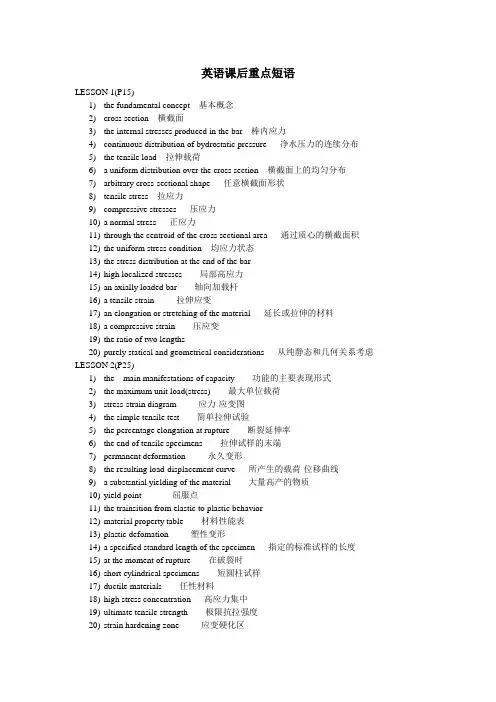
英语课后重点短语LESSON 1(P15)1)the fundamental concept 基本概念2)cross section 横截面3)the internal stresses produced in the bar 棒内应力4)continuous distribution of bydrostatic pressure 净水压力的连续分布5)the tensile load 拉伸载荷6) a uniform distribution over the cross section 横截面上的均匀分布7)arbitrary cross-sectional shape 任意横截面形状8)tensile stress 拉应力9)compressive stresses 压应力10)a normal stress 正应力11)through the centroid of the cross sectional area 通过质心的横截面积12)the uniform stress condition 均应力状态13)the stress distribution at the end of the bar14)high localized stresses 局部高应力15)an axially loaded bar 轴向加载杆16)a tensile strain 拉伸应变17)an elongation or stretching of the material 延长或拉伸的材料18)a compressive strain 压应变19)the ratio of two lengths20)purely statical and geometrical considerations 从纯静态和几何关系考虑LESSON 2(P25)1)the main manifestations of capacity 功能的主要表现形式2)the maximum unit load(stress) 最大单位载荷3)stress-strain diagram 应力-应变图4)the simple tensile test 简单拉伸试验5)the percentage elongation at rupture 断裂延伸率6)the end of tensile specimens 拉伸试样的末端7)permanent deformation 永久变形8)the resulting load-displacement curve 所产生的载荷-位移曲线9) a substsntial yielding of the material 大量高产的物质10)yield point 屈服点11)the trainsition from elastic to plastic behavior12)material property table 材料性能表13)plastic defomation 塑性变形14)a specified standard length of the specimen 指定的标准试样的长度15)at the moment of rupture 在破裂时16)short cylindrical specimens 短圆柱试样17)ductile materials 任性材料18)high stress concentration 高应力集中19)ultimate tensile strength 极限抗拉强度20)strain hardening zone 应变硬化区LESSON 3(P37)1)circular cross section 圆截面2)the position of mountings 安装位置3)nominal size 标准尺寸4)length of shaft subjected to twist 轴的受扭长度5)minimize stress concentration 尽量减小应力集中6)from the standpoint of stress 从应力角度7)equations for a shaft in pure torsion 轴纯扭转的方程式8)diameter of solid shaft 实心轴的直径9)outside diameter of hollow shaft 空心轴的外径10)the amount of twist in a shaft 轴的扭转量11)torsional deflection 扭转变形12)shear modulus of elasticity 剪切弹性模量13)be closer to the vertical load 接近于垂直载荷14)the endurance limit 疲劳极限15)the allowable shearing stress 许用剪切应力16)equation for equivalent moments 方程的等效力矩17)the design stress values for flexure 设计弯曲应力值18)the angle of twist 扭转角19)antifricton bearings 滚动轴承20)the amount of twist in a shaft 轴的扭转量LESSOM 4(P51)1)herringbone gears 人字齿轮2)spiral gears 螺旋齿轮3)worn gears 蜗轮4)bevel gears 圆锥齿轮5)hypoid gears 准双曲面齿轮6)sizes of spur-gear teeth 齿轮轮齿的尺寸7)the automotive rear axle drives 汽车后桥驱动8)rack-and-pinion drives 齿条和小齿轮驱动器9)diametral pitch 径节10)pitch circle 节圆11)the tangency point 切点12)pressure angles 压力角13)an involute curve 渐开线14)the radial distant 径向距离15)at right angles 成直角16)the average number of teeth in contact17)the reciprocal of the diametral pitch 对等径节18)to change inches to millimeters 把英寸换算成毫米19)a line perpendicular to the centerlines 垂直中心线的直线20)center distance between two meshed gears 两个齿轮的中心距LESSION 5(P62)1)plate cams 盘形凸轮2)cylindrical cams 圆柱凸轮3)the cam assembles in automatic record players 汽车发动机上的凸轮组件4)cam profiles 凸轮轮廓5)make a full-scale template 制造一个实体样板6)in the course of several revolutions of the cam 在凸轮中转几圈7) a tangential plate cam 切向盘形凸轮8) a translation cam 移动凸轮9)the groove in the periphery of the cam 凸轮表面的槽10)a guided vertical reciprocated follower 做垂直运动的往复件11)a constant-diameter cam 等径凸轮12)automatic washing machines13)a face cam 面凸轮14)the edge of a pivoted follow 摆动从动件的边缘15)a reciprocating knife-edged follower 作往复运动的刀口式从动件16)miniature snap-action electrical switchies 小的速动开关17)a pivoted flat-faced follower 安装在摆臂上的滚子从动件18)air pilot values19)the abrupt change in cam profile 在凸轮轮廓上的突变20)a Scotch yoke mechanism 苏格兰的克机构LESSION 6(P73)1)developing and demanding industry 一个处在发展中社会需要的产业2)propeller shaft 传动轴3)suspension components4) a sliding splined type of joint 滑动花键连接5)two rear axle shafts 两个后半轴6)to mesh with a larger bevel gear 与更大的锥齿轮啮合7)the universal joint 万向节8) a steering wheel 转向轮9)unevenness of road surfaces 路面的不平度10)the transverse line of the axle shafts 后横半轴11)to cause excessive tyre wear 造成轮胎的过度磨损12)the exactly similar diameter 直径非常接近13)quarter-elliptic leaf springs 四分之一随圆形钢板板式弹簧14)the transmission of shock 冲击15)road surface variation 路面变化16)the final-drive gears 最终传动齿轮副17)the precise alignment of shaft 精确同轴18)a rotating drum 转动筒鼓19)a hand lever 手刹杆20)be locked in the one position 被固定某一位置LESSION 8(P99)1)bulk deformation of metals 金属的变形2)forging,rolling or extruding 锻造滚压挤压3)plastic deformation 塑性变形4)impact blows 冲击5)the recrystallization point of the mental6)hot working and cold working 热加工和冷加工7)better surface finish8)hammer forging 锤锻9)striking the hot metal 锻打热金属10)a slow squeezing action 缓慢加压11)open dies and closed dies 开模和闭模12)bevel gears with traight or helical teeth 用直齿或螺旋加工锥齿轮13)impression dies 型腔模14)each of several die cavities 每一个模膛15)mass production16)a homogeneous circumferential grain fiow 均匀的周向纤维流17)the three-dimensional description 三维描述18)computer simulation 计算机仿真19)hydraulic presses 液压压力20)be rough- and finished-machined 粗加工和精加工LESSION 9(P110)1)carrying high-amperage current 携带高安培电流2)the electrode and the work-piece 电机和工件3)the weld pool 焊接熔池4) a column of ionized gas called plasma 一个列的电离气体称为等离子体5)the oxides and nitrides 氧化物和氮化物6)the positive ions 阳离子7)deleterious substances 有害物质8)the newly solidified mental 刚凝固的金属9)in overhead welding 仰焊10)current density 电流密度11)deposition rate 沉积速率12)an unbalanced magnetic field 不平横磁场13)arc blow 电弧偏吹14)the electrode coating 电极涂层15)in overhead position 在仰焊的位置16)the cooling rate of the deposited metal 沉积金属的冷却速度17)a more homogeneous microstructure 更均匀的微观结构18)a smooth flow of molten metal 顺畅熔融19)cellulosic-coated electrodes 纤维质涂层的焊条20)perpendicular to the current path 与电路垂直LESSION 10(P123)1)plain carbon steel 碳素钢2)carbon content 碳含量3)low carbon steel 低碳钢4)medium carbon steel 中碳钢5)high carbon steel 高碳钢6)be cold worked 冷加工7)be heat treated 热处理8)contain 20 point of carbon 含20%的碳9)in the hot-rolled condition 在热轧条件下10)heat-treat-hardened plain carbon steel 热处理硬化普通碳钢11)free-machining steels 易切削钢12)hot short 热脆性13)cold shortness 冷脆性14)the isothermal transformation curves 等温移动曲线15)grain refinement 细化晶粒16)stainless steel 不锈钢17)AISI steels 美国钢铁协会钢18)Iron-carbon equilibrium diagram 铁碳平衡表19)Tool and die steel 工具钢和模具钢20)High corrosion chemical resistance 高耐腐蚀和耐化学性能LESSION 11(P134)1)allotropic materials 同素异晶材料2)plain low carbon steel 普通低碳钢3)hypoeutectiod steel 亚共析钢4)normalized steel 正火钢5)hypereutectoid steel 过共析钢6)eutectoid composistion 共析钢7)grain houndaries 晶界8)ferrite matrix 铁氧体矩阵9)about 60℃about the Ac1 temperature 大约Ac1温度以上60摄氏度10)the nose of the I-T curve I-T曲线鼻共处11)cooling rate 冷却速率12)quenching shock 淬火介质13)thermal stress 热应力14)thermal shock 热冲击15)a tempered steel 回火钢16)temper brittlement 回火脆性17)in the tempering or drawing proceduce 在回火阶段18)hardened steel 硬化钢19)full annealing 充分退火20)to dissolve all the cementite 溶解渗碳体LESSION 15(P177)1)turning,facing and boring 车削,车端面和镗孔2)split nut 对开螺母3) a single setup of the workplace 工件在一次性定位安装4)headstock assembly 主轴箱组件5)tailstock assembly 尾座组件6)carriage assembly 溜板箱组件7)lead screw and feed rod 丝杠和光杆8)two sets of parallel,longitudinal ways 两组平行的导轨9)to assure accuracy of alignment 为了保证装配的精确度10)a set of transmission gears 一套传动齿轮11)the maximum size of bar stock 棒料的最大尺寸12)gear box 齿轮箱13)a V-belt or silent-chain drive V型带和无声传动装置14)carbide and ceramic tools 硬质合金和金属陶瓷刀15)the inner ways of the end 床身的内侧导轨16)tailstock quill 尾座套筒17)a graduated scale 通常情况18)in the direction normal to the axis of rotation of the work 在垂直工件旋转轴线方向19)manual movement of the carriage 托盘的手工移动20)per revolution of the spindle 主轴旋转一周LESSION 16 (P188)1) a multiple-tooth cutter 多齿铣刀2)progressive formation 逐渐成形3)in a direction perpendicular to the axis of the cutter 在垂直刀具轴线的方向4)the metal removal rate 金属切除率5)produce good surface finish 产生好的表面光洁度6)in job-shop and tool and die work7)teeth located un the periphery of the cutter body8)slab milling 板铣9)face milling 端面铣削10)up milling 逆铣11)down milling 顺铣12)the direction of feed of the workpiece 工件的进给方向13)the clamping device 夹具14)the smoothness of the generated surface 铣削表面的平整度15)the sharpness of the cutter edges 切削刃的锋利程度16)at the end of the tooth engagement17) p rofile cutters 仿形铣刀18) c arbide- and ceramic- tipped cutters 硬质合金及陶瓷-硬质合金刀具19)negative-rake-angle cutters 负倾角刀20)arbor cutters and shank cutters 乔木刀和柄刀。
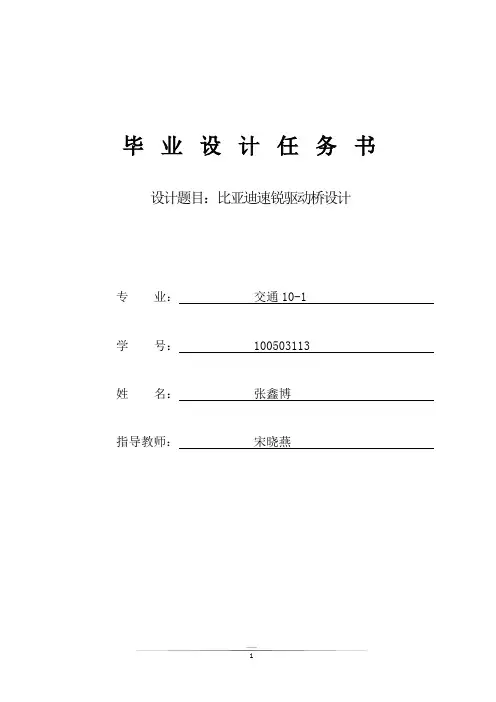
毕业设计任务书设计题目:比亚迪速锐驱动桥设计专业:交通10-1学号: ********* *名:***指导教师:***毕业设计开题报告目录摘要 (1)Abstract (1)第一章绪论 (2)1.1 本设计的目的与意义 (2)1.2 驱动桥国内外发展现状 (3)1.3 本设计的主要内容 (3)1.4 本次设计的其他数据 (3)第二章驱动桥的选型 (4)2.1 驱动桥的选型 (4)2.1.1 方案(一):非断开式驱动桥 (5)2.1.2 方案(二):断开式驱动桥 (6)2.1.3 方案(三):多桥驱动的布置 (7)第三章驱动半轴的设计 (9)3.1 半轴的结构形式分析 (9)3.2 半轴的强度计算 (10)半浮式半轴计算载荷的确定 (11)a 半轴在纵向力最大时 (11)b 半轴在侧向力最大时 (11)c 半轴在垂向力最大时 (13)3.3 半轴的强度计算 (13)a 纵向力最大时, (13)b 侧向力最大时 (14)c 垂向力最大时 (14)3.4 半轴花键的设计 (14)3.5 半轴的材料及热处理半轴的材料及热处理 (16)3.5.1 半轴的工作条件和性能要求 (16)3.5.2 处理技术要求 (16)3.5.3 选择用钢 (16)3.5.4 半轴的工艺路线 (17)3.5.5 热处理工艺分析 (17)第四章驱动桥壳的设计 (18)4.1 驱动桥壳结构方案选择 (18)a 可分式桥壳 (18)b 整体式桥壳 (18)c 组合式桥壳 (19)4.2 驱动桥壳强度计算 (20)4.2.1 桥壳的静弯曲应力计算 (20)4.2.2 在不平路面冲击载荷作用下的桥壳强度计算 (21)4.2.3 汽车以最大牵引力行驶时的桥壳强度计算 (22)4.2.4 紧急制动时的桥壳强度计算 (23)4.2.5 汽车受最大侧向力时的桥壳强度计算 (24)第五章轮胎的选取 (26)5.1 轮胎与车轮应满足的基本要求 (26)5.2 轮胎的特点与选用 (26)5.3 轮胎的选型及尺寸参数 (26)第六章CAD进行建模装配 (28)6.1 CAD的介绍 (28)6.2 CAD建模过程 (28)6.2.1 车桥的建模 (28)6.2.2 半轴的建模 (31)6.2.3 轴承和螺栓的建模 (31)6.2.4 车轮的建模 (33)6.3实体装配 (34)总结 .............................................................................................................................. 错误!未定义书签。
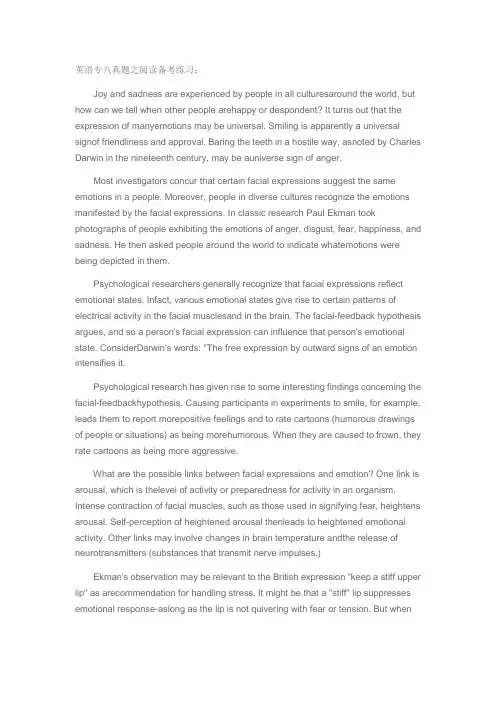
英语专八真题之阅读备考练习:Joy and sadness are experienced by people in all culturesaround the world, but how can we tell when other people arehappy or despondent? It turns out that the expression of manyemotions may be universal. Smiling is apparently a universal signof friendliness and approval. Baring the teeth in a hostile way, asnoted by Charles Darwin in the nineteenth century, may be auniverse sign of anger.Most investigators concur that certain facial expressions suggest the same emotions in a people. Moreover, people in diverse cultures recognize the emotions manifested by the facial expressions. In classic research Paul Ekman took photographs of people exhibiting the emotions of anger, disgust, fear, happiness, and sadness. He then asked people around the world to indicate whatemotions were being depicted in them.Psychological researchers generally recognize that facial expressions reflect emotional states. Infact, various emotional states give rise to certain patterns of electrical activity in the facial musclesand in the brain. The facial-feedback hypothesis argues, and so a person's facial expression can influence that person's emotional state. ConsiderDarwin's words: "The free expression by outward signs of an emotion intensifies it.Psychological research has given rise to some interesting findings concerning the facial-feedbackhypothesis. Causing participants in experiments to smile, for example, leads them to report morepositive feelings and to rate cartoons (humorous drawings of people or situations) as being morehumorous. When they are caused to frown, they rate cartoons as being more aggressive.What are the possible links between facial expressions and emotion? One link is arousal, which is thelevel of activity or preparedness for activity in an organism. Intense contraction of facial muscles, such as those used in signifying fear, heightens arousal. Self-perception of heightened arousal thenleads to heightened emotional activity. Other links may involve changes in brain temperature andthe release of neurotransmitters (substances that transmit nerve impulses.)Ekman's observation may be relevant to the British expression "keep a stiff upper lip" as arecommendation for handling stress. It might be that a "stiff" lip suppresses emotional response-aslong as the lip is not quivering with fear or tension. But whenthe emotion that leads to stiffeningthe lip is more intense, and involves strong muscle tension, facial feedback may heighten emotionalresponse.1. The word despondent in the passage is closest in meaning toA curiousB unhappyC thoughtfulD uncertain2. The author mentions "Baring the teeth in a hostile way" in order toB upport Darwin's theory of evolution3. The word concur in the passage is closest in meaning toA estimateB agreeC expectD understand4. According to paragraph 2, which of the following was true of the Fore people ofNew Guinea?A They did not want to be shown photographs.B They were famous for their story-telling skills.C They knew very little about Western culture.D They did not encourage the expression of emotions.5. According to the passage, what did Darwin believe would happen to human emotions that werenot expressed?A They would become less intense.B They would last longer than usual.C They would cause problems later.D They would become more negative.参考答案:B C B C AASCI Purple will be used to simulate nuclear explosions in 3-D"ASCI紫色计算机"将被用于三维模拟核爆炸Scientists will soon be able to observe the first instants after a nuclear warhead detonates. Fortunately, it will be a three-dimensional simulation, made possible by the world's fastest computer. IBM and the U.S. Department of Energy announced Tuesday the sale of a $290 million supercomputer, capable of performing 100 trillion calculations per second. Armed with that much computing firepower, a 3-D simulation of the first one-millionth of a second in a nuclear explosion will take eight weeks to calculate.科学家不久将能观察到核弹头爆炸的第一瞬间。

大学英语阅读实践考试题及答案一、阅读理解A篇Passage 1In the small town of Greenfield, there is a unique tradition that has been carried out for over a century. Every year, on the first Sunday of July, the townspeople gather at the local park to celebrate the "Greenfield Flower Festival." The festival is a colorful event featuring a parade of floats adorned with fresh flowers, live music, and a competition for the most beautifully arranged flower bouquet.The festival's origins date back to 1892 when the town's horticulturist, Miss Emily Greenfield, decided to organize a flower show to promote the local flora and to bring the community together. Over the years, the event has grown in popularity and now attracts visitors from neighboring towns and even from abroad.At the heart of the festival is the "Flower Queen" competition, where young women from the town participate by creating their own flower bouquets. The winner is crowned the "Flower Queen" and leads the parade, symbolizing the beauty and unity of the community.Questions:1. What is the main event of the Greenfield Flower Festival?2. Who started the festival and why?3. What is the significance of the "Flower Queen" in the festival?答案:1. The main event of the Greenfield Flower Festival is the parade of floats adorned with fresh flowers.2. The festival was started by Miss Emily Greenfield, the town's horticulturist, to promote the local flora and to bring the community together.3. The "Flower Queen" is significant as she symbolizes the beauty and unity of the community and leads the parade.B篇Passage 2Technology has revolutionized the way we communicate, work, and learn. One of the most significant advancements in recent years is the development of virtual reality (VR). VR is a computer-generated simulation that allows users to immerse themselves in a three-dimensional environment.The applications of VR are vast and varied. In the field of education, VR can provide students with a more interactive and engaging learning experience. For instance, history students can virtually visit ancient civilizations, and science students can explore the human body in 3D.In healthcare, VR is used for both treatment and training. Medical professionals can use VR to simulate surgeries and train for complex procedures. Additionally, VR has been found to be effective in treating certain phobias and anxiety disorders by exposing patients to controlled, virtual environments.Questions:1. What is virtual reality (VR)?2. How is VR used in education?3. What are some applications of VR in healthcare?答案:1. Virtual reality (VR) is a computer-generated simulation that allows users to immerse themselves in a three-dimensional environment.2. In education, VR can provide students with a more interactive and engaging learning experience, such asvirtually visiting ancient civilizations or exploring the human body in 3D.3. In healthcare, VR is used for medical training by simulating surgeries and for treatment, such as treating phobias and anxiety disorders through controlled virtual environments.二、完形填空Passage 3Many people believe that success is the result of hard work and determination. However, some argue that it is 1) luckthat plays a crucial role. While there is no denying thateffort is important, there are times when being in the right place at the right time can make all the difference.Consider the story of John, who was a 2) waiter at a small restaurant. One day, a famous movie director visited the restaurant and was impressed by John's friendly and outgoing personality. The director 3) offered John a role in his upcoming film, which 4) turned out to be a major box office hit. John's career as an actor was launched, and he became a 5) star overnight.It is easy to attribute John's success to luck, but it isalso important to recognize the role of his 6) personalityand 7) attitude. Had John not been a friendly and positive individual, the director might not have taken notice of him. Therefore, while luck may have played a part, it was John's 8) character that ultimately led to his success.Choose the correct word to fill in the blanks:1) a) luck b) skill c) money2) a) waiter b) doctor c) engineer3) a) offered b) refused c) demanded4) a) turned out b) gave up c) looked forward to5) a) star b) extra c) director6) a) personality b) age c) height7) a) attitude b) wealth c) education8) a) character b) appearance c) intelligence答案:1) a) luck2)。
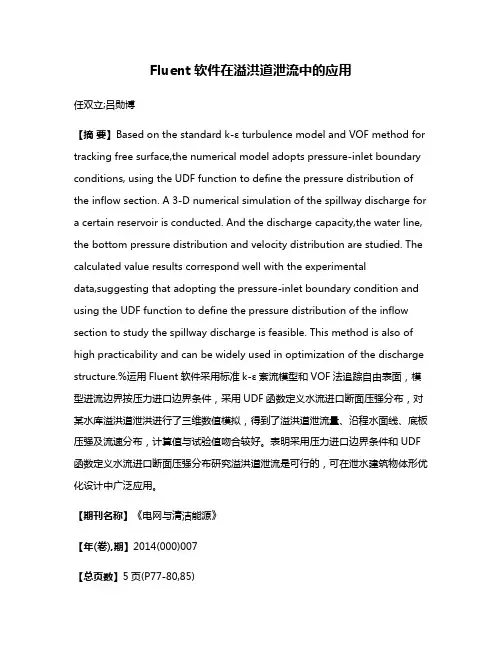
Fluent软件在溢洪道泄流中的应用任双立;吕勋博【摘要】Based on the standard k-ε turbulence model and VOF method for tracking free surface,the numerical model adopts pressure-inlet boundary conditions, using the UDF function to define the pressure distribution of the inflow section. A 3-D numerical simulation of the spillway discharge for a certain reservoir is conducted. And the discharge capacity,the water line, the bottom pressure distribution and velocity distribution are studied. The calculated value results correspond well with the experimentaldata,suggesting that adopting the pressure-inlet boundary condition and using the UDF function to define the pressure distribution of the inflow section to study the spillway discharge is feasible. This method is also of high practicability and can be widely used in optimization of the discharge structure.%运用Fluent软件采用标准k-ε紊流模型和VOF法追踪自由表面,模型进流边界按压力进口边界条件,采用UDF函数定义水流进口断面压强分布,对某水库溢洪道泄洪进行了三维数值模拟,得到了溢洪道泄流量、沿程水面线、底板压强及流速分布,计算值与试验值吻合较好。
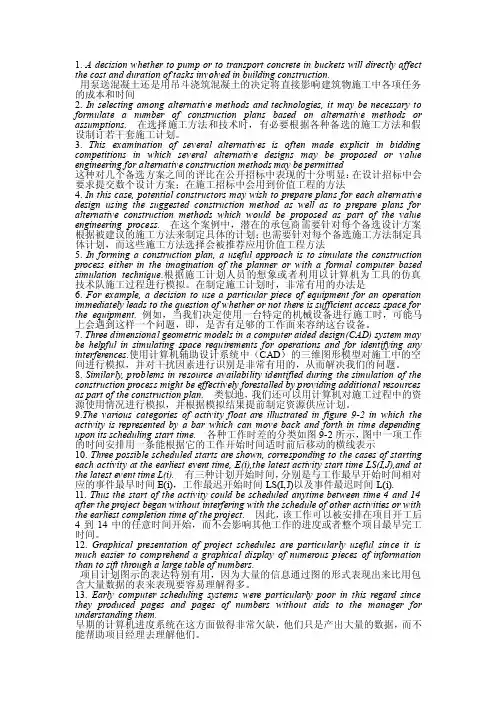
1. A decision whether to pump or to transport concrete in buckets will directly affect the cost and duration of tasks involved in building construction.用泵送混凝土还是用吊斗浇筑混凝土的决定将直接影响建筑物施工中各项任务的成本和时间2.In selecting among alternative methods and technologies, it may be necessary to formulate a number of construction plans based on alternative methods or assumptions. 在选择施工方法和技术时,有必要根据各种备选的施工方法和假设制订若干套施工计划。
3.This examination of several alternatives is often made explicit in bidding competitions in which several alternative designs may be proposed or value engineering for alternative construction methods may be permitted这种对几个备选方案之间的评比在公开招标中表现的十分明显:在设计招标中会要求提交数个设计方案;在施工招标中会用到价值工程的方法4. In this case, potential constructors may wish to prepare plans for each alternative design using the suggested construction method as well as to prepare plans for alternative construction methods which would be proposed as part of the value engineering process.在这个案例中,潜在的承包商需要针对每个备选设计方案根据被建议的施工方法来制定具体的计划;也需要针对每个备选施工方法制定具体计划,而这些施工方法选择会被推荐应用价值工程方法5.In forming a construction plan, a useful approach is to simulate the construction process either in the imagination of the planner or with a formal computer based simulation technique.根据施工计划人员的想象或者利用以计算机为工具的仿真技术队施工过程进行模拟。
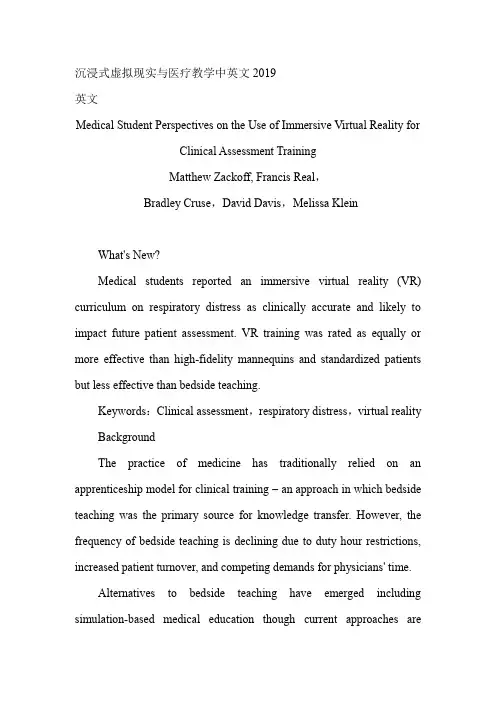
沉浸式虚拟现实与医疗教学中英文2019英文Medical Student Perspectives on the Use of Immersive Virtual Reality forClinical Assessment TrainingMatthew Zackoff, Francis Real,Bradley Cruse,David Davis,Melissa KleinWhat's New?Medical students reported an immersive virtual reality (VR) curriculum on respiratory distress as clinically accurate and likely to impact future patient assessment. VR training was rated as equally or more effective than high-fidelity mannequins and standardized patients but less effective than bedside teaching.Keywords:Clinical assessment,respiratory distress,virtual reality BackgroundThe practice of medicine has traditionally relied on an apprenticeship model for clinical training – an approach in which bedside teaching was the primary source for knowledge transfer. However, the frequency of bedside teaching is declining due to duty hour restrictions, increased patient turnover, and competing demands for physicians' time.Alternatives to bedside teaching have emerged including simulation-based medical education though current approaches arelimited in applicability to and functionality for pediatric training. For instance, standardized patients are not available for many pediatric conditions especially for diseases that predominantly affect infants. Moreover, patient simulators often cannot display critical physical exam findings for discriminating between sick and healthy patients (eg mental status, work of breathing, perfusion changes).An emerging educational modality, immersive virtual reality (VR), could potentially fill this gap. Immersive VR utilizes a three-dimensional, computer generated environment in which users interact with graphical characters (avatars). While screen-based simulation training has been demonstrated to enhance learning outcomes, immersive VR has the potential to have a broader impact through increased learner engagement, and improved spatial representation and learning contextualization. To date, this technology has demonstrated effectiveness in communication skills training; however, it has not been investigated for clinical assessment training. To evaluate the role of immersive VR in medical student clinical assessment training, we created a VR curriculum focused on respiratory distress in infants. Our pilot study explored medical student attitudes toward VR and perceptions of VR compared to other common medical educational methods.Educational Approach and InnovationSetting and Study PopulationAn IRB approved prospective pilot study was conducted at Cincinnati Children's Hospital Medical Center, a large academic children's hospital, during the 2017 to 2018 academic year. A randomized sample of third-year medical students, based upon predetermined clinical team assignment during their pediatric rotation, was invited to participate in a VR curriculum.Curriculum DesignThe curricular goal, to improve third year medical students' ability to appropriately categorize a pediatric patient's respiratory status, aligns with an Association of American Medical Colleges Core Entrustable Professional Activity for entering residency, the ability to recognize a patient that requires an urgent or emergent escalation of care.To address this goal, an immersive VR curriculum using the clinical scenario of an admitted infant with bronchiolitis was developed collaboratively between clinicians, educators, and simulation developers.A virtual Cincinnati Children's Hospital Medical Center inpatient hospital room was created using the Unity development platform and was experienced through an Oculus Rift headset. The environment included a vital signs monitor, virtual stethoscope, and avatars for the patient and preceptor. The patient avatar could demonstrate key exam findings (ie mental status, work of breathing, and breath sounds) that correlated with three clinical scenarios: 1) no distress, 2) respiratory distress, and 3)impending respiratory failure. The displayed vital signs and auscultatory findings matched the clinical status of the patient. Learners received feedback on their performance immediately following each simulated case. The preceptor avatar, controlled by a physician facilitator (M.Z., F.R.), guided the student through the VR simulation. Learners were expected to recognize and interpret the vital signs, physical exam, and auscultatory findings and come to an overall assessment of the patient's respiratory status. Detailed algorithms correlating learner input to avatar responses allowed for standardization of the avatar preceptor prompts. For example, if a student did not comment on the patient's lung sounds, the facilitator is guided to select the avatar prompt, “What do you think of his lung sounds?” Facilitator-provided feedback for each scenario was standardized to ensure consistent learner experiences.Scenarios were piloted on four critical care attending physicians, two hospitalists, two general pediatricians, four critical care fellows, four senior pediatric residents, and four medical students to assess the accuracy of the findings portrayed in the clinical scenarios as well as the feasibility of the planned facilitation. Iterative changes were made to the VR simulation based upon feedback.Survey Design and ImplementationImmediately following the VR curriculum, students completed a survey to assess immersion within the VR environment using questionsderived from a validated instrument.15 Demographic data and attitudes toward the VR curriculum including its perceived effectiveness compared to other education methods were assessed on a 5-point Likert scale via a survey created de novo with piloting prior to use. Survey results were analyzed with binomial testing.ResultsAll eligible students consented to participate in the research study (n = 78). Ages ranged from 20 to 39 with an equal distribution between male and female. Students self-identified as White (51.3%), Asian (28.2%), Black (7.7%), Hispanic/Latino (3.9%), or other (9.0%). Most students reported a strong sense of presence in the VR environment (85%) and the vast majority noted that the scenarios captured their attention and senses (96% and 91%, respectively).A majority of students agreed or strongly agreed that that the simulations were clinically accurate (97.4%), reinforced key learning objectives (100%), and would impact future care provision (98.7%). In addition, students reported VR training as more effective (P < .001) than reading, didactic teaching, online learning, and low fidelity mannequins. VR training was rated as equally or more effective (P < .001) than high fidelity mannequins and standardized patients. The only modality that VR was rated less effective than was bedside teaching.Figure. Binomial testing demonstrates that a statistical majority of students found virtual reality training more effective than reading, didactic teaching, online learning, and low fidelity mannequins, and equally or more effective than high fidelity mannequins and standardized patients.Discussion and Next StepsThis study represents a novel application of immersive VR for medical student training. The majority of student participants reported a sense of presence within the VR environment and identified the modality as equal or superior in perceived effectiveness to other training options such as standardized patients and high-fidelity mannequin simulations while rated less effective than bedside teaching. These findings are consistent with the findings of Real et al13 that learners perceived VR as equally effective to standardized patients for communication training. Our learners expressed similar perceptions regarding the use of VR forclinical assessment training –expanding the potential applications forVR-based education.The assessment of a patient's respiratory status, and importantly the recognition of need for emergent escalation of care is a core clinical competency that directly relates to patient safety. The ability of immersive VR to convey specific critical exam findings could aid in accelerating junior learners' competence related to identification of impending respiratory failure and potentially impact future care provision. The learnings from this pilot could be applied to other clinical scenarios (eg sepsis) given immersive VR's ability to accurately simulate key exam findings.This study has several limitations. First, it was conducted at a single site with only third year medical students. Second, the evaluation focused on students' perceptions toward the effectiveness of VR-based education in general rather than specifically focusing on VR-based education on pediatric respiratory distress. Though we could not standardize students' exposure to the comparison education modalities, all students underwent a high-fidelity simulation focused on respiratory distress as part of their pediatric rotation. This high fidelity simulation occurred prior to the VR curriculum, and thus represented a consistent reference for all of the students who completed the study survey.A final significant consideration for this study is the generalizability of the approach. With each passing year and iteration of availableequipment, the cost of VR compatible headsets and computers continue to fall. We utilized the Oculus Rift headset and a VR capable computer, which together cost on the order of $2000. The development platform, Unity, is an open source platform available at no cost. We are fortunate to have VR developers as employees of our simulation center, facilitating the development of new scenarios, and represent a resource that may currently be unavailable at many other institutions.Next steps include establishing response process validity through assessment of learner application of knowledge gained during the VR curriculum. Additional research goals include exploring the effectiveness of immersive VR at additional sites to assess generalizability, directly comparing VR head-to-head with other educational modalities (eg standardized patients, high-fidelity simulations), and evaluating change in actual clinical practice as well as the costs associated with these modalities to explore the feasibility of broader implementation of VR training. The findings from this pilot study suggest that immersive VR may be an effective supplement to bedside teaching due to its ability to accurately represent real-life environments and clinical scenarios in a standardized format that is safe for learners and patients.中文使用沉浸式虚拟现实进行医学临床培训的研究什么是新的?医学院的学生报告说,关于呼吸窘迫的沉浸式虚拟现实(VR)课程在临床上是准确且有效的,并且可能会影响未来的患者救治效果。
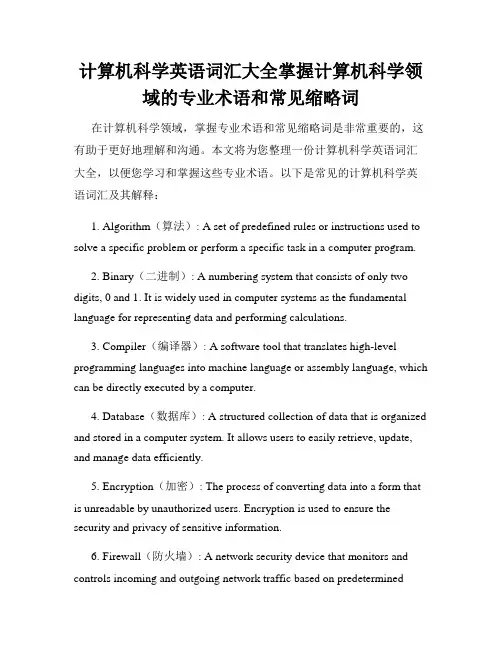
计算机科学英语词汇大全掌握计算机科学领域的专业术语和常见缩略词在计算机科学领域,掌握专业术语和常见缩略词是非常重要的,这有助于更好地理解和沟通。
本文将为您整理一份计算机科学英语词汇大全,以便您学习和掌握这些专业术语。
以下是常见的计算机科学英语词汇及其解释:1. Algorithm(算法): A set of predefined rules or instructions used to solve a specific problem or perform a specific task in a computer program.2. Binary(二进制): A numbering system that consists of only two digits, 0 and 1. It is widely used in computer systems as the fundamental language for representing data and performing calculations.3. Compiler(编译器): A software tool that translates high-level programming languages into machine language or assembly language, which can be directly executed by a computer.4. Database(数据库): A structured collection of data that is organized and stored in a computer system. It allows users to easily retrieve, update, and manage data efficiently.5. Encryption(加密): The process of converting data into a form that is unreadable by unauthorized users. Encryption is used to ensure the security and privacy of sensitive information.6. Firewall(防火墙): A network security device that monitors and controls incoming and outgoing network traffic based on predeterminedsecurity rules. It acts as a barrier between a trusted internal network and untrusted external networks.7. HTML (Hypertext Markup Language)(超文本标记语言): The standard markup language used for creating and structuring web pages. It defines the structure and layout of the content on a webpage.8. GUI (Graphical User Interface)(图形用户界面): A visual interface that allows users to interact with a computer or software using graphical elements, such as windows, icons, buttons, and menus.9. Kernel(内核): The core component of an operating system that manages system resources and provides low-level services to other software applications.10. Machine Learning(机器学习): A branch of artificial intelligence that enables computer systems to learn and improve from experience without being explicitly programmed. It focuses on the development of algorithms that can analyze and interpret data to make predictions or decisions.11. Network(网络): A collection of interconnected devices, such as computers, servers, routers, and switches, that allows for the exchange of data and resources.12. Object-Oriented Programming(面向对象编程): A programming paradigm that organizes software design around objects, rather than logic and procedures. It emphasizes the reusability, modularity, and extensibility of code.13. Protocol(协议): A set of rules and standards that govern the communication between devices on a network. Protocols ensure that data is transmitted and received correctly.14. Query(查询): A request for specific information or data from a database using a query language, such as SQL (Structured Query Language).15. RAM (Random Access Memory)(随机存取存储器): A type of computer memory that stores data that is being actively used by a computer program. It allows for faster access to data compared to other types of storage.16. Software Development(软件开发): The process of designing, coding, testing, and maintaining software applications and systems. It involves various stages, such as requirements analysis, design, implementation, and deployment.17. TCP/IP (Transmission Control Protocol/Internet Protocol)(传输控制协议/互联网协议): A set of networking protocols that allows computers to communicate and exchange data over the internet. It provides a reliable and standardized method for transmitting data packets.18. Virtual Reality(虚拟现实): A computer-generated simulation of a three-dimensional environment that can be interacted with and explored by a user. It typically involves the use of specialized hardware, such as headsets and motion controllers.19. Web Development(网站开发): The process of creating and maintaining websites and web applications. It includes tasks such as webdesign, web content development, client-side scripting, and server-side scripting.20. XML (eXtensible Markup Language)(可扩展标记语言): A markup language that is designed to store and transport data. It is widely used for representing and exchanging structured data over the internet.这些是计算机科学中的一些常见英语词汇和术语。
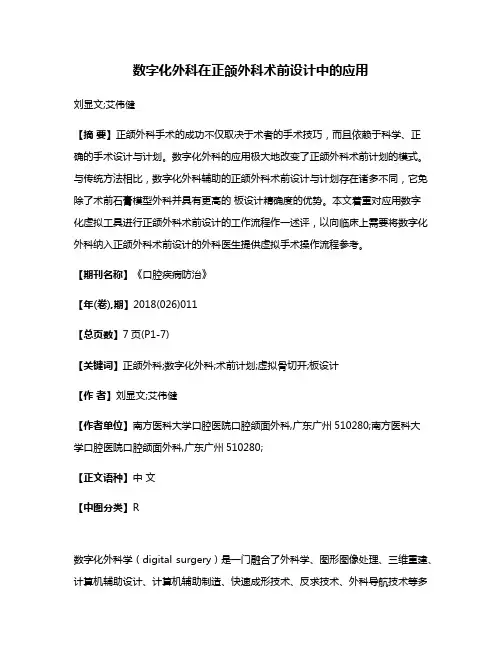
数字化外科在正颌外科术前设计中的应用刘显文;艾伟健【摘要】正颌外科手术的成功不仅取决于术者的手术技巧,而且依赖于科学、正确的手术设计与计划。
数字化外科的应用极大地改变了正颌外科术前计划的模式。
与传统方法相比,数字化外科辅助的正颌外科术前设计与计划存在诸多不同,它免除了术前石膏模型外科并具有更高的板设计精确度的优势。
本文着重对应用数字化虚拟工具进行正颌外科术前设计的工作流程作一述评,以向临床上需要将数字化外科纳入正颌外科术前设计的外科医生提供虚拟手术操作流程参考。
【期刊名称】《口腔疾病防治》【年(卷),期】2018(026)011【总页数】7页(P1-7)【关键词】正颌外科;数字化外科;术前计划;虚拟骨切开;板设计【作者】刘显文;艾伟健【作者单位】南方医科大学口腔医院口腔颌面外科,广东广州510280;南方医科大学口腔医院口腔颌面外科,广东广州510280;【正文语种】中文【中图分类】R数字化外科学(digital surgery)是一门融合了外科学、图形图像处理、三维重建、计算机辅助设计、计算机辅助制造、快速成形技术、反求技术、外科导航技术等多种先进技术的交叉学科,其可以为临床医师提供三维实物模型,术前进行可视化手术设计和模拟,协助制作复杂手术方案,术中导航精确实现术前设计,术后量化评估手术效果[1]。
近年来数字化外科技术在国内外得到了迅速的发展和应用,本文针对其在口腔颌面外科的分支学科—正颌外科中的发展与应用作一述评。
1 数字化外科在正颌外科中的发展应用近30年以来,正颌外科已经发展成为治疗牙颌面畸形的一项成熟而安全的外科技术[2⁃4]。
传统的正颌外科通过临床体检、头影测量分析、石膏模型外科等步骤制作板用作术中导航,其缺点主要是由于头影测量分析是二维图像,因此,基于对头影描迹图的裁剪、移动、和拼对难以模拟颌骨在三维空间的移动;另外,模型外科技术需要先用面弓转移关系到架上,继而对牙颌模型进行移动、切割和拼对,步骤繁琐,易于产生误差[5]。
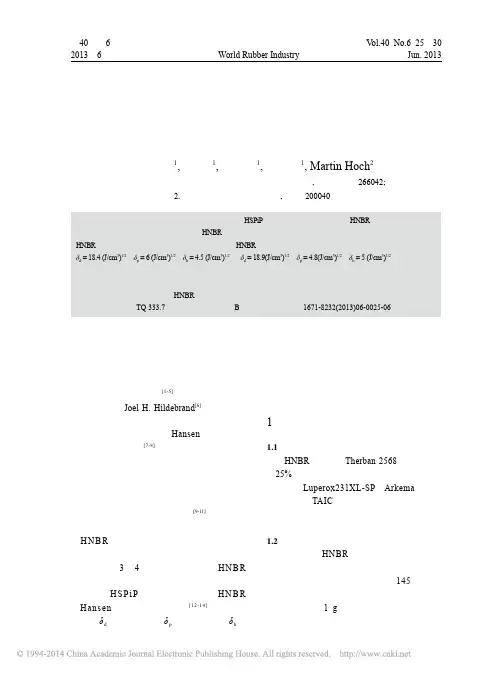
第40卷第6期2013年6月世界橡胶工业World Rubber Industry 溶解度参数在预测耐化学试剂的渗透性和聚合物之间的相容性,特别在溶剂的选择方面,有着广泛的应用[1-5]。
溶解度参数的概念,首先是由Joel H. Hildebrand [6]提出来的,它被定义为物质内聚能密度的平方根。
经过数年的研究提出了二维,Hansen 三维甚至是四维的溶解度参数[7-8]。
小分子物质的溶解度参数可以直接由蒸发焓计算得出,而大分子聚合物由于尚未达到蒸发所需要的热焓,就已经热分解了,所以,只能用间接法求取大分子聚合物的溶解度参数(如滴定法,气相色谱法,黏度法以及溶胀法等)[9-11]。
本文采用溶胀法测定了氢化丁腈橡胶(H N B R )的溶解度参数。
与以往溶胀法实验不同的是,文中溶胀试验进行了简化处理,选择3到4组二元混合溶剂对HNBR 进行溶胀试验,然后将所得结果引入计算机软件(H S P i P )进行处理,得到H N B R 的Hansen 三维溶解度参数值[12-14],即色散力分量δd ,极性力分量δp 和氢键力分量δh 。
关于溶胀法及计算机模拟HNBR三维溶解度参数的研究橡胶的三维溶解度参数值在橡胶溶剂的选择,高聚物多组分相容性的预测等方面,更具有应用价值。
1 实 验1.1 主要原料HNBR ,牌号:Therban 2568,丙烯腈含量25%,朗盛化学(中国)公司提供;防焦烧交联剂,Luperox231XL-SP ,Arkema 提供;助交联剂:TAIC ,上海景惠化工厂提供;溶剂,均为市售工业品。
1.2 实验方法首先,对HNBR 进行硫化(交联)。
为了减少硫化胶内小分子杂质以及气泡对溶胀试验结果的影响,硫化温度选择145 ℃,并且无其它填料填充。
然后,将其裁切成形状相同、质量为1 g 左右的小圆片。
用氯苯对小圆片进行抽提,除去其中未交联组分,并刘广永1, 裘 文1, 商元元1, 邱桂学1, Martin Hoch 2(青岛科技大学 橡塑材料与工程教育部重点实验室, 山东 青岛 266042;2.朗盛化学(中国)有限公司, 上海 200040)V ol.40 No.6:25~30Jun. 2013摘要:研究了用溶胀法测定,以及计算机程序(HSPiP )模拟计算氢化丁腈橡胶(HNBR )的三维溶解度参数值,对比了单溶剂溶胀和混合溶剂溶胀HNBR 得到的三维溶解度参数值。
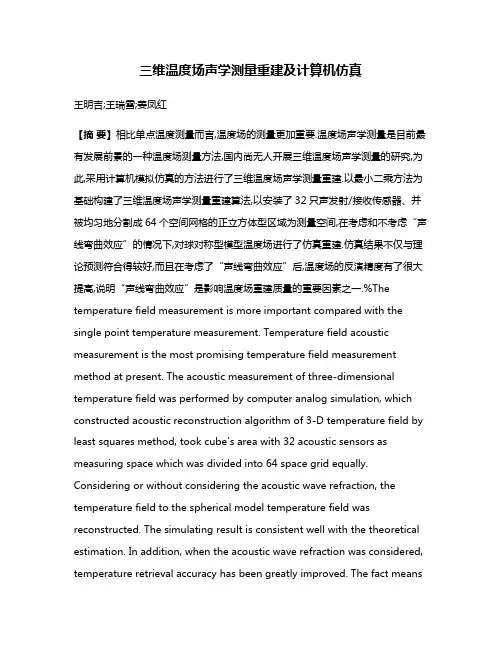
三维温度场声学测量重建及计算机仿真王明吉;王瑞雪;姜凤红【摘要】相比单点温度测量而言,温度场的测量更加重要.温度场声学测量是目前最有发展前景的一种温度场测量方法,国内尚无人开展三维温度场声学测量的研究,为此,采用计算机模拟仿真的方法进行了三维温度场声学测量重建.以最小二乘方法为基础构建了三维温度场声学测量重建算法,以安装了32只声发射/接收传感器、并被均匀地分割成64个空间网格的正立方体型区域为测量空间,在考虑和不考虑“声线弯曲效应”的情况下,对球对称型模型温度场进行了仿真重建.仿真结果不仅与理论预测符合得较好,而且在考虑了“声线弯曲效应”后,温度场的反演精度有了很大提高,说明“声线弯曲效应”是影响温度场重建质量的重要因素之一.%The temperature field measurement is more important compared with the single point temperature measurement. Temperature field acoustic measurement is the most promising temperature field measurement method at present. The acoustic measurement of three-dimensional temperature field was performed by computer analog simulation, which constructed acoustic reconstruction algorithm of 3-D temperature field by least squares method, took cube's area with 32 acoustic sensors as measuring space which was divided into 64 space grid equally. Considering or without considering the acoustic wave refraction, the temperature field to the spherical model temperature field was reconstructed. The simulating result is consistent well with the theoretical estimation. In addition, when the acoustic wave refraction was considered, temperature retrieval accuracy has been greatly improved. The fact meansthat acoustic wave refraction is one of the important factors to the temperature field reconstruction.【期刊名称】《现代电子技术》【年(卷),期】2012(035)001【总页数】4页(P121-123,128)【关键词】温度场;声学测量;声线追踪;最小二乘法;仿真【作者】王明吉;王瑞雪;姜凤红【作者单位】东北石油大学,黑龙江大庆163318;东北石油大学,黑龙江大庆163318;东北石油大学,黑龙江大庆163318【正文语种】中文【中图分类】TN911.7-34;TP391.90 引言众所周知,“温度”既具有统计特性,又具有“三维”的含义,也就是说,在三维空间中无处不存在“温度”的量值,实际上是一个“温度场”的概念。
浙江省温州市乐清外国语学校2022-2023学年九年级上学期期末英语试题学校:___________姓名:___________班级:___________考号:___________一、完形填空Sometimes my bad mood feels like quicksand, and the harder I try to climb out, the more stuck I get! That was true last week. I was reading a book. I had just come to the most“Haha! Definitely.” I laughed.“Hey!” said Craig. “That 14 you just made sounded a lot like a laugh.”Just when I think I’ll 15 be in a bad mood, I’m suddenly on the other side of it. I smiled. “Possibly.”1.A .whoB .whatC .whenD .where 2.A .heldB .sentC .turnedD .opened 3.A .angrilyB .silentlyC .carelesslyD .proudly 4.A .nothingB .anythingC .somethingD .everything 5.A .leftB .dancedC .droveD .returned 6.A .todayB .tonightC .tomorrowD .yesterday 7.A .hopedB .endedC .sharedD .started 8.A .changeB .chanceC .secretD .reason 9.A .onlyB .evenC .alsoD .still 10.A .inB .onC .byD .for 11.A .broke upB .broke inC .broke downD .broke off 12.A .adviceB .courageC .surprisesD .decisions 13.A .lyingB .sittingC .jumpingD .hanging 14.A .poemB .songC .noiseD .story 15.A .oftenB .alwaysC .neverD .hardly16.Where is the Solar Egg Frying Competition held?A.Texas.B.Austin.C.Arizona.D.South America. 17.When is the day about a drink from South America?A.June 4.B.June 11.C.September 9.D.December 13. 18.What can we learn from the three titles?A.Dates of some surprising holidays.B.Important holidays in the US.C.Places for celebrating different holidays.D.Reasons to celebrate a few holidays.Without the Internet or phones, communicating long distance is limited. Yet throughout history, cultures have developed ways to produce messages that travel miles. Morse Code is a system of communication. It uses patterns of signals to send and receive messages, often with a machine called a telegraph.A telegraph is a machine that creates different signals from different messages. These signals are then changed into electrical current. They are sent across a wire. They can travel long distances, such as across the country or ocean. Another telegraph receives these signals. The machine changes the signals back into the original message.In Morse Code, there are three types of signals. They are dots, dashes, and pauses. Dots (•) are the short noises or flashes of light. Dashes (━) are longer noises or flashes of light. Spaces (____) are the pauses. Patterns of these signals represent letters, numbers, and punctuation marks. In Morse Code, letter A is one dot and one dash, letter E is one dot, letter Iis two dots. As for consonants, letter C is one dash, one dot, one dash and one dot, letter D is one dash and two dots, Letter T is one dash.Morse Code was invented in the United States by Samuel Morse during the 1830s. People soon realized that the code could not transmit all messages in other languages. To fix this problem, a newer version called the International Morse Code was developed. International Morse Code is simpler and more exact. For example, the original Morse Code could only represent a few of the letters. The International Morse Code, on the other hand, is for all letters.19.According to Paragraph 2, how does the telegraph work?━The signals are sent across a wire.━The signals are changed back to letters.━Another telegraph receives these signals.━The telegraph changes signals to electricity.A.━━━━B.━━━━C.━━━━D.━━━━20.Look at the signals: •━━•━•━, which of the following do they mean?A.Cat.B.Act.C.Eat.D.Ted. 21.What happened after Morse Code couldn’t work in other languages?A.It became very popular.B.People stopped using it.C.The telephone was invented.D.A newer version was created. 22.What is the writing purpose of this passage?A.To explain a secret message.B.To introduce a type of phone.C.To show a way to communicate.D.To tell stories of an old machine.Cathy Hackl’s son wanted a party for his 9th birthday. He wanted to hold the party on Roblox, a website where users can play and create games. Roblox is part of the metaverse. This is a virtual-reality space. There, users can interact with other people and digital environments. Virtual reality is a three-dimensional simulation of a real-life image or environment. “They hung out and played, ” Hackl said, “Just because it happens in a virtual space doesn’t make it less real.” The term metaverse has become popular. Today, people arespending more of their lives in virtual spaces.The word metaverse comes from a science fiction book from the 1990s. But the metaverse has been around longer than that. Online communities have existed since the 1980s. We enter the metaverse through a screen. This could be through virtual reality(VR). It could also be through augmented reality(AR). Augmented reality covers computer-generated images on the real world. These experiences create a greater blending of our virtual and real lives. But these two worlds already cannot be separated and we don’t even need any headsets, such as VR glasses. Think about the Didi Taxi app. It uses location data to tell drivers where their cars are.The metaverse is an expansion of the Internet. There are lots of Internet problems to solve already. Still, many people say it has real benefits. They say it can increase social networks and improve mental health. Hackl is a metaverse expert, and she’s African. She says, “You can encourage a lot more people to join and build social relations.” For those already spending part of their life in the metaverse, that building has begun.Carrie Tatsu runs a business in the metaverse. But she wants her kids to spend time in the real world. “It’s so important for humans to be with humans in real life, ” she said, “I think as kids grow up in this space, it’s important for them to take part, go smell a flower here, walk on a trail, have a real conversation with a friend. Even though you can simulate that, the simulation is not the same. ”23.How does the writer lead in metaverse in Paragraph 1?A.By telling stories.B.By listing numbers.C.By describing people.D.By comparing facts.A.Changing.B.Entering.C.Mixing.D.Reaching. 25.What’s the structure of the passage?A.B.C.D.26.Which of the following can be the title for the passage?A.Metaverse: virtual spaces online.B.Metaverse: a science-fiction book.C.Metaverse: a popular computer game.D.Metaverse: businesses on the Internet.三、多任务混合阅读I ran back to Grandpa’s garden as fast as I could with Grandpa’s dog, Bandit. “Grandpa, I heard something strange in your woods!” I told him.“Let’s go and find out what it is, Sarah,” he took my hand. My grandpa lives alone near the woods. Sometimes I go into the woods with Bandit and pretend I am Sarah the Adventurer. But I can’t go past the big rock so that Grandpa can always see me from the garden.As we hiked toward the big rock, there was that sound! Cack-cack-cack-cack! “What is that, Grandpa?” I whispered.“It’s the first sign of spring,” he said. “How about you go past the big rock a bit to find out what it is.”“No,” I looked at Grandpa. His whole face seemed to be smiling. I wondered what an adventurer would do. “Grandpa,” I said, “I think I can do it.”Grandpa said, “It’s all right, just a little further.”As I went past the rock, suddenly there was silence. When I got closer, I heard Grandpa say, “Just sit down and watch.”I sat down but I didn’t see any animals. Just ahead of me there was a big puddle. Then I found something in the puddle. “Frogs!” I shouted.“They’re calling because it’s time for them to lay eggs. Next time we’ll check for tadpoles,” he told me.On my next visit, I went straight down to the puddle with Grandpa. To discover the frogs, I walked closer to the puddle. “Keep going, Sarah, just a little further,” Grandpa said.I took a big pace forward. I’m Sarah the Adventurer!Soon I saw some brown tadpoles. I got one tadpole home.Grandpa helped me feed it. Each time I came, it was bigger. First, its back legs came out. Then front legs. Grandpa said, “it’s time for it to return home.”This time, I was brave enough to go ahead of Grandpa. I reached into the jar and got the little tadpole. I hold it out to the water. It wouldn’t move. “It’s all right, just a little further,” I said. I touched its tail, and it jumped right into the water.As I headed back, holding Grandpa’s hand, I looked back and smiled. There wassomething special in Grandpa’s woods.27.Why did Sarah run back to Grandpa’s garden?A.Sarah fell off the big rock when climbing.B.Sarah heard a strange noise in the woods.C.Sarah heard Bandit barking at something.D.Sarah saw tadpoles jumping out ofa puddle.28.What happened after Grandpa told Sarah to sit down and watch?A.Sarah took Grandpa’s hand.B.Sarah hiked toward the big rock.C.Sarah saw several frogs in a puddle.D.Sarah pretends to be Sarah theAdventurer.29.Which of the following describes Grandpa?A.Grandpa thinks Sarah’s fears are silly.B.Grandpa is kind and patient with Sarah.C.Grandpa is worried about Sarah in the woods.D.Grandpa thinks Sarah should treat animals better.40 words. )四、多句选词填空五、短文汉语提示填空根据短文内容和所给中文提示,用单词的正确形式完成下列短文。
vr简介中英文版对照怎么写虚拟现实技术是一种可以创建和体验虚拟世界的计算机仿真系统,利用计算机生成一种模拟环境,下面是店铺给大家整理的vr简介中英文版,供大家参阅!vr简介Virtual reality technology is an important direction of simulation technology. It is a collection of various technologies such as simulation technology and computer graphics, human interface technology, multimedia technology, sensor technology and network technology. It is a challenging cross technology frontier and research field The Virtual reality technology (VR) mainly includes simulation environment, perception, natural skills and sensing equipment and so on. The simulation environment is a computer generated, real-time dynamic three-dimensional realistic image. Perception refers to the ideal VR should have all the people have the perception. In addition to computer graphics technology generated by visual perception, there are auditory, tactile, force, movement and other perception, and even including the sense of smell and taste, also known as multi-perception. Natural skill refers to the person's head rotation, eyes, gestures, or other human behavior, by the computer to deal with the action of the participants to adapt to the data, and the user's input to make real-time response, and were fed back to the user's facial features The A sensing device is a three-dimensional interactive device.虚拟现实技术是仿真技术的一个重要方向,是仿真技术与计算机图形学人机接口技术多媒体技术传感技术网络技术等多种技术的集合,是一门富有挑战性的交叉技术前沿学科和研究领域。
Computer simulationA computer simulation, a computer model, or a computational model is a computer program, or network of computers, that attempts to simulate an abstract model of a particular system. Computer simulations have become a useful part of mathematical modeling of many natural systems in physics (computational physics), astrophysics, chemistry and biology, human systems in economics, psychology, social science, and engineering. Simulations can be used to explore and gain new insights into new technology, and to estimate the performance of systems too complex for analytical solutions.Computer simulations vary from computer programs that run a few minutes, to network-based groups of computers running for hours, to ongoing simulations that run for days. The scale of events being simulated by computer simulations has far exceeded anything possible (or perhaps even imaginable) using the traditional paper-and-pencil mathematical modeling. Over 10 years ago, a desert-battle simulation, of one force invading another, involved the modeling of 66,239 tanks, trucks and other vehicles on simulated terrain around Kuwait, using multiple supercomputers in the DoD High Performance Computer Modernization Program;a 1-billion-atom model of material deformation (2002); a 2.64-million-atom model of the complex maker of protein in all organisms, a ribosome, in 2005;[3] and the Blue Brain project at EPFL (Switzerland), began in May 2005, to create the first computer simulation of the entire human brain, right down to the molecular level.[Simulation versus modelingTraditionally, forming large models of systems has been via a mathematical model, which attempts to find analytical solutions to problems and thereby enable the prediction of the behavior of the system from a set of parameters and initial conditions.While computer simulations might use some algorithms from purely mathematical models, computers can combine simulations with reality or actual events, such as generating input responses, to simulate test subjects who are no longer present.Whereas the missing test subjects are being modeled/simulated, the system they use could be the actual equipment, revealing performance limits or defects in long-term use by these simulated users.Note that the term computer simulation is broader than computer modeling, which implies that all aspects are being modeled in the computer representation. However, computer simulation also includes generating inputs from simulated users to run actual computer software or equipment, with only part of the system being modeled: an example would be flight simulators which can run machines as well as actual flight software.Computer simulations are used in many fields, including science, technology, entertainment, health care, and business planning and puter simulation was developed hand-in-hand with the rapid growth of the computer, following its first large-scale deployment during the Manhattan Project in World War II to model the process of nuclear detonation. It was a simulation of 12 hard spheres using a Monte Carlo algorithm. Computer simulation is often used as an adjunct to, or substitution for, modeling systems for which simple closed form analytic solutions are not possible. There are many different types of computer simulations; the common feature they all share is the attempt to generate a sample of representative scenarios for a model in which a complete enumeration of all possible states of the model would be prohibitive or impossible. Computer models were initially used as a supplement for other arguments, but their use later became rather widespread.Computer simulation in scienceComputer simulation of the process of osmosisGeneric examples of types of computer simulations in science, which are derived from an underlying mathematical description:a numerical simulation of differential equations which cannot be solved analytically, theories which involve continuous systems such as phenomena in physical cosmology, fluid dynamics (e.g. climate models, roadway noise models, roadway air dispersion models), continuummechanics and chemical kinetics fall into this category.a stochastic simulation, typically used for discrete systems where events occur probabilistically, and which cannot be described directly with differential equations (this is a discrete simulation in the above sense). Phenomena in this category include genetic drift, biochemical or gene regulatory networks with small numbers of molecules. (see also: Monte Carlo method).Specific examples of computer simulations follow:statistical simulations based upon an agglomeration of a large number of input profiles, such as the forecasting of equilibrium temperature of receiving waters, allowing the gamut of meteorological data to be input for a specific locale. This technique was developed for thermal pollution forecasting .agent based simulation has been used effectively in ecology, where it is often called individual based modeling and has been used in situations for which individual variability in the agents cannot be neglected, such as population dynamics of salmon and trout (most purely mathematical models assume all trout behave identically).time stepped dynamic model. In hydrology there are several such hydrology transport models such as the SWMM and DSSAM Models developed by the U.S. Environmental Protection Agency for river water quality puter simulations have also been used to formally model theories of human cognition and performance, e.g. ACT-Rcomputer simulation using molecular modeling for drug puter simulation for studying the selective sensitivity of bonds by mechanochemistry during grinding of organic molecules.]Computational fluid dynamics simulations are used to simulate the behaviour of flowing air, water and other fluids. There are one-, two- and three- dimensional models used. A one dimensional model might simulate the effects of water hammer in a pipe. A two-dimensional model might be used to simulate the drag forces on the cross-section of an aeroplane wing. A three-dimensional simulation might estimate the heating and cooling requirements of a large building.An understanding of statistical thermodynamic molecular theory is fundamental to the appreciation of molecular solutions. Development of the Potential Distribution Theorem (PDT) allows one to simplify this complex subject to down-to-earth presentations of molecular theory.Notable, and sometimes controversial, computer simulations used in scienceinclude: Donella Meadows' World3 used in the Limits to Growth, James Lovelock's Daisyworld and Thomas Ray's puter simulation in practical contexts.Smog around Karl Marx Stadt (Chemnitz), Germany: computer simulation in 1990Computer simulations are used in a wide variety of practical contexts, such as:analysis of air pollutant dispersion using atmospheric dispersion modelingdesign of complex systems such as aircraft and also logistics systems.design of Noise barriers to effect roadway noise mitigation.flight simulators to train pilots.weather forecasting.Simulation of other computers is emulation..forecasting of prices on financial markets (for example Adaptive Modeler).behavior of structures (such as buildings and industrial parts) under stress and other conditions.design of industrial processes, such as chemical processing plants.Strategic Management and Organizational Studies.Reservoir simulation for the petroleum engineering to model the subsurface reservoir.Process Engineering Simulation tools.Robot simulators for the design of robots and robot control algorithms.Urban Simulation Models that simulate dynamic patterns of urban development and responses to urban land use and transportation policies. See a more detailed article on Urban Environment Simulation.Traffic engineering to plan or redesign parts of the street network from single junctions over cities to a national highway network, for transportation system planning, design and operations. See a more detailed article on Simulation in Transportation.modeling car crashes to test safety mechanisms in new vehicle modelsThe reliability and the trust people put in computer simulations depends on the validity of the simulation model, therefore verification and validation are of crucial importance in the development of computer simulations. Another important aspect of computer simulations is that of reproducibility of the results, meaning that a simulation model should not provide a different answer for each execution. Although this might seem obvious, this is a special point of attention in stochastic simulations, where random numbers should actually be semi-random numbers. An exception to reproducibility are human in the loop simulations such as flight simulations and computer games. Here a human is part of the simulation and thus influences the outcome in a way that is hard if not impossible to reproduce exactly.Vehicle manufacturers make use of computer simulation to test safety features in new designs. By building a copy of the car in a physics simulation environment, they can save the hundreds of thousands of dollars that would otherwise be required to build a unique prototype and test it. Engineers can step through the simulation milliseconds at a time to determine the exact stresses being put upon each section of the prototype.[7]Computer graphics can be used to display the results of a computer simulation. Animations can be used to experience a simulation in real-time e.g. in training simulations. In some cases animations may also be useful in faster than real-time or even slower than real-time modes. For example, faster than real-time animations can be useful in visualizing the buildup of queues in the simulation of humans evacuating a building. Furthermore, simulation results are often aggregated into static images using various ways of scientific visualization.In debugging, simulating a program execution under test (rather than executing natively) can detect far more errors than the hardware itself can detect and, at the same time, log useful debugging information such as instruction trace, memory alterations and instruction counts. This technique can also detect buffer overflow and similar "hard to detect" errors as well as produce performance information and tuning data.。
挤出模具设计要点欧洲特别是德国是塑料门窗异型材的发祥地,塑料挤出技术和理论也比较发达,许多挤出模的设计思想都源于此。
文献[1]提出了著名的横向流动最小化(Cross Flows Minimized)原则。
认为熔体流过一系列的截面,把截面再分为不同的小段,通过调整截面形状尺寸,使截面上各个区域上的质量流率成比例,其比例大小为该截面区域占截面总面积之比。
该思想比较经典,与挤出模机颈段建模方法中的面积测绘法有异曲同工之妙。
文献[2]进一步发展了这种思想,总结了调节流动平衡的方法和数值分析的三种途径,讨论了横截面计算和单独流动对挤出流动的影响。
波兰Sarsaw 理工大学的K.Wilczynski在《A computer model for a polymer single-screw extrusion》中提出了一个针对单螺杆挤出成型过程的计算机模型SSEM。
SSEM能模拟挤出成型的全过程,可根据给定的工艺参数预测流动特性。
在实验中对其设计及模拟的正确性进行了检验,试验对比显示模拟结果与实测数据相差4%~10%,其设计具有较高的可信度。
英国Dundee大学的G S H Chan和K K B Hon在《Integration of computing techniques for plastics extrusion die design》中介绍了他们应用DUCT软件根据给定的模头进口截面与模头出口截面尺寸自动生成流线型挤出流道。
为使DUCT软件设计简单,文献中作了两个假设,即模头进口截面形状恒为圆形和模头出口截面尺寸等于异型材产品截面尺寸,即不考虑离模膨胀问题。
文中总结了以前两种生成流道的常规算法,对其作了巧妙的修改与组合,思路非常新颖。
Queen's University of Belfast的Sun Da-Wen和华南理工大学的彭玉成指出,目前异型材挤出制品应用很广,但其模具设计很复杂,现有的文献介绍实际设计经验的很少,因而他们在《Practical method to design hollow profile dies》中提出了一种简单的设计异型材挤出流道轮廓的方法,其依据条件是熔体在挤出模模头出口流速一致,该方法利用过渡线理论(transitional line method)与变流道厚度法理论(variable channel thickness method)对组成整个挤出流道的每一块模块型腔轮廓进行计算,并且在设计中考虑了各模块组合成整体型腔的平衡问题。
水泥水化及其微结构发展的计算机模拟陈彩艺(福州大学土木工程学院,福建福州 350108)摘要:近几十年来,水泥水化及其结构演化的计算机模拟技术得到了迅速发展,先后经历了单晶体颗粒模型、数字成核生长模型、及当前的三维微结构发展模型。
对用来理解硅酸钙相水化形成过程和水泥矿物质在水中的溶解的分子规模模拟方法都进行了讨论(其中最具代表性模型有连续基模型和数字图像基模型),并对水泥水化模型模拟未来发展提出个人看法。
关键字:水泥水化、模型、微结构、三维计算机模拟Modeling and simulation of cement hydration and microstructuredevelopmentChen Caiyi(College of Civil Engineering, Fuzhou University, Fuzhou, Fujian Province 350108, China)Abstract: In the past decades years, cement hydration and its structure evolution of computer simulation technology have developed rapidly, covering different modeling approaches such as single particle models, mathematical nucleation and growth models to simulating microstructure development. Applications of molecular-scale simulation methodsto understanding the structure and formation of calcium silicate-hydrate phases, and to understanding the process of dissolution of cement minerals in water (continuum-based model and digital-image-based model) are also discussed. And the future development of cement hydration model and simulation is put forward.Keywords:Cement hydration; Modeling; Microstructure; three-dimensional computer modeling1 前言在胶凝材料中,水泥基材料占有突出的地位,它是基本建设的主要原材料之一,广泛应用于工业、农业、交通、城市建设、水利以及海洋开发等工程建设。
诚信声明本人郑重声明:本论文及其研究工作是本人在指导教师的指导下独立完成的,在完成论文时所利用的一切资料均已在参考文献中列出。
本人签名:年月日毕业设计任务书设计题目:基于UG的家电(风扇)三维造型设计及动态仿真系部:机械工程系专业:机械电子工程学号:112012129学生:指导教师(含职称):(副教授) (助教)1.课题意义及目标学生应通过本次毕业设计,综合运用所学过的基础理论知识,深入了解UG在机械设计方案比选、结构刚度分析等方面的设计规范、计算方法及设计思想等内容,为学生在毕业后从事机械技术工作打好基础。
2.主要任务(1)对电风扇的基础零件三维绘制。
(2)对电风扇基础零件进行装配,完成装配体。
(3)利用三维建模、装配约束、干涉检测等功可以对电风扇运动仿真。
(4)对虚拟装配理论和关键技术进行研究。
(5)按照学院毕业设计说明书撰写要求,写出设计说明书一份。
3.主要参考资料[1] 张继春,杨建国.装配设计与运动仿真[2] UG运动仿真教程[EB/OL].[3] 郑伯学,吴俊海. 现代制造环境下的CAD技术[J].煤矿机械.2006,09 4.进度安排审核人:基于UG的家电(风扇)三维造型设计及动态仿真摘要:计算机技术和计算机图形学的不断发展,三维CAD/CAM/CAE集成化软件被广泛使用于制造业。
与传统的装配设计相比,虚拟装配技术可以满足并行工程的要求,实现产品可装配的设计,及时发现产品设计中的问题,提高装配质量和装配效果。
[1]课题研究的是在UG软件设计平台上完成风扇的三维造型设计。
立式电风扇的外形结构较为复杂,如果用传统的CAD绘图软件设计非常困难,UG可以使轻松解决这个问题,UG 软件具有很强大的实体造型、曲面造型、虚拟产品装配仿真、工程图生成等功可以。
论文以从实物到模具的逆向设计过程论述了风扇虚拟设计中的关键环节。
关键词:三维造型设计,虚拟装配,运动仿真Three dimensional modeling and dynamic simulation of home appliances(fan)based on UGAbstract:The continuous development of computer technology, three-dimensional CAD/CAM/CAE integration software is widely used in manufacturing. Compared with the traditional assembly design, virtual assembly technology to meet the requirements of concurrent engineering, the design of their products can be equipped with timely detection of problems in product design, improve the assembly quality and assembly efficiency.This thesis based on UG product design platform for the fan completed the three-dimensional design. The shape structure of vertical electric fan is very complex, if using the traditional CAD drawing software to design will be very difficult, UG can easily solve this problem, the UG software has powerful functions of solid modeling, surface modeling, virtual assembly simulation, engineering drawing and others. This paper discussed the key link of fan that using reversal design progress from the physical to the mold in virtual design.Keywords: 3D modeling design, simulation assembly, movement simulation目录1绪论 (1)1.1 三维造型设计的现状和发展前景 (1)1.2 常用三维造型软件的了解 (1)1.3 UG软件了解的 (2)1.4 论文研究的内容和意义 (2)2基于UG的风扇设计 (3)2.1 电风扇的发展现状 (3)2.2 UG在产品中的设计思路 (3)2.3 电风扇的建模设计分析 (3)2.3.1 电风扇的虚拟装配了解的 (3)2.4 电风扇主要零件的建模绘制 (4)2.4.1 电风扇前罩的绘制 (4)2.4.2 电风扇后罩的绘制 (7)2.4.3 电风扇叶片的绘制 (9)2.4.4 电风扇后座的绘制 (15)2.4.5 电风扇底盘的绘制 (20)2.4.6 电风扇支架模块的绘制 (23)2.4.7 电风扇操作面板的绘制 (28)2.4.8 电风扇其他零件的绘制 (32)2.5 电风扇的装配体建模及爆炸图 (33)2.5.1 装配风扇本体 (33)2.5.2 电风扇的爆炸图及干涉分析 (35)3动态仿真 (36)3.1 关于动态仿真 (36)3.2 电风扇的动态仿真 (36)4结论与展望 (38)4.1 结论 (38)4.2 不足之处及展望 (38)参考文献 (39)致谢 (40)1绪论利用三维建模软件进行设计,给许多行业带来了翻天覆地的变化,尤其是制造业。